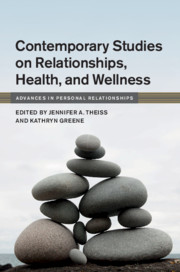Book contents
- Contemporary Studies on Relationships, Health, and Wellness
- Advances in Personal Relationships
- Contemporary Studies on Relationships, Health, and Wellness
- Copyright page
- Dedication
- Contents
- Figures
- Tables
- Contributors
- Acknowledgments
- Introduction
- Part I Interpersonal Influence in Health and Relationships
- Part II Information Management in Health and Relationships
- Part III Uncertainty in Health and Relationships
- Part IV Support and Caregiving in Health and Relationships
- 11 Family Reactions to Partner Stress and Depression in Same-Sex Couples
- 12 “I Just Want My Wife and My Life Back”: Men’s Experiences of Stress and Social Support during Their Partner’s Postpartum Depression
- 13 Communication Skills (Comskil) Training for Oncology Nurses to Improve Patient-Centered Care
- Part V Communication Patterns in Health and Relationships
- Epilogue
- Index
- References
12 - “I Just Want My Wife and My Life Back”: Men’s Experiences of Stress and Social Support during Their Partner’s Postpartum Depression
from Part IV - Support and Caregiving in Health and Relationships
Published online by Cambridge University Press: 09 November 2018
- Contemporary Studies on Relationships, Health, and Wellness
- Advances in Personal Relationships
- Contemporary Studies on Relationships, Health, and Wellness
- Copyright page
- Dedication
- Contents
- Figures
- Tables
- Contributors
- Acknowledgments
- Introduction
- Part I Interpersonal Influence in Health and Relationships
- Part II Information Management in Health and Relationships
- Part III Uncertainty in Health and Relationships
- Part IV Support and Caregiving in Health and Relationships
- 11 Family Reactions to Partner Stress and Depression in Same-Sex Couples
- 12 “I Just Want My Wife and My Life Back”: Men’s Experiences of Stress and Social Support during Their Partner’s Postpartum Depression
- 13 Communication Skills (Comskil) Training for Oncology Nurses to Improve Patient-Centered Care
- Part V Communication Patterns in Health and Relationships
- Epilogue
- Index
- References
- Type
- Chapter
- Information
- Contemporary Studies on Relationships, Health, and Wellness , pp. 246 - 265Publisher: Cambridge University PressPrint publication year: 2018

